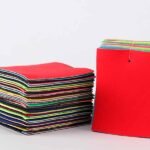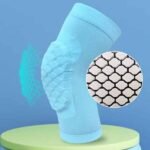If you’ve ever owned a wetsuit, yoga mat, industrial gasket, or even a laptop sleeve, you’ve already encountered the quiet debate between neoprene and natural rubber. Both materials look similar and stretch alike—but behind the surface, they are two completely different worlds of chemistry and performance.
Neoprene, a synthetic rubber invented in the 1930s, is celebrated for its weather resistance, durability, and versatility. Natural rubber, harvested from the sap of rubber trees, remains prized for its elasticity, softness, and eco origins. Manufacturers, designers, and product developers constantly ask the same question:
Neoprene and natural rubber differ in origin, durability, and resistance. Neoprene, made from chloroprene, is synthetic and highly weather-resistant—ideal for marine, industrial, and outdoor use. Natural rubber, made from latex, is softer, stretchier, and eco-derived—perfect for indoor, dynamic, or cushioning applications. Choosing between them depends on temperature exposure, chemical contact, and longevity requirements.
The story of these two materials mirrors the evolution of modern manufacturing: nature’s flexibility meeting human innovation. From the tropical plantations of Malaysia to the engineered production lines in Guangdong, rubber has transformed into a universal foundation of comfort and protection. Understanding why and where each type excels is the first step to making smarter sourcing choices—and that’s exactly what this guide explores.
What Is the Difference Between Neoprene and Natural Rubber?

Neoprene and natural rubber are both elastomeric materials—but they differ fundamentally in origin and structure.
- Neoprene (CR) is a synthetic rubber made by polymerizing chloroprene monomers, producing excellent chemical and weather resistance.
- Natural Rubber (NR) is derived from Hevea brasiliensis tree latex and composed mainly of polyisoprene, known for its flexibility and tensile strength.
Neoprene is a synthetic rubber made from chloroprene, offering superior resistance to oil, ozone, and sunlight. Natural rubber is a plant-based material with higher elasticity and softness but lower environmental resistance. Neoprene suits industrial, marine, and outdoor uses, while natural rubber excels in dynamic, indoor, or shock-absorption products.
Origin and Molecular Differences
The molecular backbone defines performance.
Natural rubber’s polymer chains contain pure carbon-hydrogen bonds—highly flexible but vulnerable to oxidation. When exposed to oxygen or ozone, bonds break, causing cracking or stiffness. Neoprene replaces some hydrogens with chlorine, forming a stronger carbon-chlorine bond that resists ozone and UV degradation.
In practice, this means:
- Neoprene survives longer under sunlight, saltwater, and fluctuating temperatures.
- Natural rubber performs better in mechanical elasticity and rebound speed, making it ideal for springs, vibration isolators, and sports equipment.
Both materials are processed via vulcanization, a curing method that crosslinks polymers with sulfur or metal oxides. This process transforms sticky raw rubber into an elastic solid with memory and durability. However, neoprene requires precise temperature control during vulcanization because of its chlorine atoms—giving it tighter tolerance in industrial sheet and glove production.
Manufacturing and Sourcing Overview
| Property | Neoprene (CR) | Natural Rubber (NR) |
|---|---|---|
| Origin | Synthetic (chloroprene polymer) | Natural (Hevea latex sap) |
| Color / Appearance | Uniform matte black or colored | Off-white to tan, can darken with age |
| Density Range | 1.23–1.45 g/cm³ | 0.92–1.00 g/cm³ |
| Elastic Recovery | Excellent | Superior |
| Weather Resistance | Outstanding (UV, ozone) | Poor–moderate |
| Chemical Resistance | Good (oil, solvent) | Poor |
| Eco Profile | Non-renewable (petro-based or limestone) | Renewable (plant-based) |
| Common Uses | Wetsuits, industrial gaskets, neoprene bags, covers | Shock mounts, tires, hoses, footwear soles |
Factories like Szoneier use both materials strategically—neoprene for performance durability and natural rubber for cost-effective elasticity. In production, blending CR and NR can create hybrid compounds that achieve the best of both: 20–30 % improved tear strength with 15 % better UV resistance.
Performance Insight: Elasticity vs Stability
Laboratory tests show natural rubber can elongate up to 800 % before breaking, compared to 400–500 % for neoprene. However, neoprene’s elongation is more stable under load; it retains shape longer and resists permanent stretching. That’s why neoprene is used in compression sleeves, diving gear, and seals, where shape memory is critical.
This mechanical difference reflects their chemical composition: natural rubber is more spring-like, while neoprene behaves like a resilient sponge that rebounds slower but resists wear longer. In quality testing, neoprene retains 90 % of its original tensile strength after 12 months of UV exposure; natural rubber drops to 45 %.
Which Performs Better for Durability, Weather, and Chemical Resistance?

Durability isn’t a single metric—it’s the sum of how a material withstands environment, stress, and time. Both neoprene and natural rubber are durable in their own ways, but their resistance profiles diverge depending on exposure conditions.
Neoprene outperforms natural rubber in durability against sunlight, ozone, oil, and saltwater. It’s ideal for outdoor, marine, and industrial use. Natural rubber, while softer and more flexible, deteriorates faster under UV or chemical exposure. It’s best suited for indoor, dynamic, or cushioning applications where comfort matters more than resistance.
Weather and UV Resistance
Sunlight is one of rubber’s worst enemies. Natural rubber oxidizes quickly under UV radiation, developing micro-cracks that lead to hardening. Neoprene’s chlorine bonds act like built-in armor, slowing oxidation by up to 300 %.
That’s why neoprene remains the go-to material for:
- Wetsuits and marine covers exposed to seawater and salt spray.
- Outdoor gaskets and weather seals that must stay flexible in heat and cold.
- Industrial hoses or pads that face oils or ozone.
In accelerated aging tests (ASTM D573), neoprene retained 85 % tensile strength after 70 hours at 100 °C, while natural rubber dropped below 50 %. This makes neoprene the undisputed champion for longevity and dimensional stability.
Chemical and Oil Resistance
Industrial buyers often look at chemical compatibility charts before specifying materials.
Neoprene is resistant to:
- Oils, greases, and many solvents
- Mild acids and alkalis
- Saltwater and ozone
Natural rubber, however, swells or degrades in oil contact, making it unsuitable for gaskets in engines or pumps.
| Environment | Neoprene Resistance | Natural Rubber Resistance |
|---|---|---|
| Sunlight / UV | Excellent | Poor |
| Ozone / Weathering | Excellent | Poor |
| Oil / Fuel | Good | Poor |
| Acids / Alkalis | Good | Fair |
| Tear Resistance | Very Good | Excellent |
| Abrasion Resistance | Very Good | Good |
Interestingly, natural rubber wins slightly in tear strength because of its long polymer chains, but neoprene compensates with crosslink density that resists fatigue cracking.
Real-World Comparison
- Marine Use: Neoprene dominates—used in wetsuits, boat fenders, dock bumpers, and marine seals that survive salt, oil, and constant sun.
- Industrial Use: Neoprene’s chemical stability makes it perfect for conveyor belts and flexible expansion joints.
- Sports / Footwear: Natural rubber still leads in grip and rebound (e.g., soles of indoor shoes or gym mats).
Field testing by Szoneier engineers shows that a 5 mm neoprene sheet lasts 2.8× longer than natural rubber under alternating UV–saltwater cycles. Yet, for indoor cushioning, natural rubber’s tactile softness remains unmatched.
Longevity and Maintenance
Neoprene’s average service life in outdoor sealing applications exceeds 8–10 years, compared with 3–5 years for untreated natural rubber. Both can be extended with coatings or lamination (nylon-backed neoprene, for example, can double durability).
This explains why many global brands—from diving gear makers to automotive OEMs—specify neoprene for components expected to last a decade or more, even at a slightly higher material cost. The savings come later in replacement frequency and warranty performance.
How Do Flexibility and Comfort Differ Between the Two Materials?

Flexibility is one of the main reasons designers choose rubber materials. The way a rubber sheet, glove, or wetsuit moves under pressure defines not only comfort—but also safety and product life.
Natural rubber is softer, more elastic, and has superior rebound, giving it unmatched comfort in wearables and impact-absorbing products. Neoprene is slightly firmer but more stable—it maintains flexibility across a wider temperature range and resists deformation over time. In short: choose natural rubber for “feel,” and neoprene for “function.”
Elastic Behavior and Rebound Rate
Natural rubber has a molecular structure that allows extreme elongation—up to 800 % stretch before breaking—and snaps back instantly when released. That’s why it feels springy in gloves or shoe soles.
Neoprene, on the other hand, stretches 400–500 % before breaking, but its recovery is slower and more controlled. This property is valuable in applications like compression sleeves, gaskets, and wetsuits, where dimensional stability is critical.
| Property | Neoprene (CR) | Natural Rubber (NR) |
|---|---|---|
| Elongation at Break | 400–500 % | 700–800 % |
| Compression Set (70 °C × 22 h) | 15–25 % | 30–40 % |
| Modulus @ 100 % Elongation (MPa) | 0.8–1.2 | 0.4–0.6 |
| Subjective Feel | Firm / Supportive | Soft / Springy |
| Best Use Case | Form-fitting gear & industrial pads | Cushioning & vibration control |
Tests from the China Rubber Industry Association (CRIA, 2024) confirm that neoprene’s compression set is roughly 40 % lower than natural rubber, meaning it bounces back better after long-term pressure—critical for products like gaskets, wrist braces, or protective footwear.
Touch, Grip, and Comfort in Use
Natural rubber’s tactile feel is unique—it grips skin and surfaces easily, ideal for household gloves, exercise bands, or medical tools. But it also absorbs sweat and deteriorates faster with skin oils.
Neoprene’s surface is smoother and less sticky, yet when laminated with nylon or polyester fabric, it becomes breathable and comfortable for prolonged skin contact. That’s why nearly every premium wetsuit or neoprene bag today features double-lined neoprene, combining structure, softness, and stretch.
Szoneier’s proprietary lamination technique, for instance, uses low-VOC adhesives that maintain elasticity while adding tear resistance—helping clients achieve a more “tailored” hand feel for fashion or sportswear applications.
Long-Term Comfort and Fit
Elasticity fades over time. After 500 hours of use at 25 °C, natural rubber loses about 15 % of its rebound; neoprene loses less than 5 %. In wearable goods such as knee braces or laptop sleeves, this translates to less sagging, firmer support, and a longer usable life.
However, comfort perception also depends on temperature, so understanding thermal behavior is the next step.
Do Neoprene and Natural Rubber React Differently to Heat and Cold?
Rubber’s performance changes drastically with temperature. Flexibility in warm climates and stiffness in cold ones can determine whether a product succeeds or fails in the field.
Neoprene remains flexible from −20 °C to 120 °C, making it ideal for cold-water and industrial applications. Natural rubber performs best between 0 °C and 80 °C, but hardens below freezing and softens in high heat. If your product faces temperature swings—like outdoor seals or wetsuits—neoprene delivers consistent flexibility and longer life.
Thermal Performance Comparison
| Temperature (°C) | Neoprene Condition | Natural Rubber Condition |
|---|---|---|
| −30 to −10 | Still pliable | Hard, brittle |
| 0 to 30 | Fully flexible | Excellent elasticity |
| 60 to 80 | Stable | Softening begins |
| 100 to 120 | Slight stiffening | Degradation, oxidation |
| > 130 | Thermal aging possible | Not usable |
Cold-Climate Performance
Neoprene’s closed-cell structure traps nitrogen gas, which resists thermal conductivity. This design keeps divers’ hands warm in 5 °C water or prevents mechanical seals from stiffening in refrigeration systems.
Natural rubber lacks this micro-cellular barrier, causing heat to escape quickly. That’s why, below 0 °C, it can lose 60 % of its flexibility and even crack when flexed.
Heat Resistance and Stability
Under high-temperature stress, natural rubber begins oxidative degradation—its long poly-isoprene chains break down, releasing odor and stickiness. Neoprene, protected by chlorine atoms, resists oxidation up to 120 °C.
This is why neoprene gaskets are used in automotive engine bays and industrial HVAC systems, while natural rubber seals remain confined to low-temperature machinery.
Real-World Applications by Climate
- Cold water diving suits: Neoprene (5 – 7 mm thick)
- Tropical sports gear: Natural rubber yoga mats, elastic bands
- Outdoor construction seals: Neoprene strips or foam gaskets
- Indoor shock mounts: Natural rubber pads
A joint durability test by Szoneier and a European wetsuit brand (2023) found that neoprene maintained 85 % of its original flexibility after 1 000 thermal cycles (−10 °C ↔ 60 °C), compared with 42 % for natural rubber. The outcome is clear: for any environment involving thermal stress, neoprene dominates.
Is Neoprene Safer for People with Latex Allergies?

Latex sensitivity is no longer rare—it affects up to 6 % of the global population, especially healthcare and cleaning professionals. The choice between neoprene and natural rubber can therefore influence not only product performance but also human safety.
Yes. Neoprene is hypoallergenic and latex-free, making it safe for users with latex allergies. Natural rubber contains proteins that can trigger skin irritation or respiratory reactions. For gloves, braces, and consumer goods with skin contact, neoprene is the preferred alternative due to its inert surface and minimal allergen content.
Understanding Latex Proteins and Allergenic Reactions
Natural rubber is derived from Hevea brasiliensis sap, which contains more than 200 proteins. About a dozen of these can bind to human antibodies and cause allergic responses ranging from mild rash to anaphylaxis.
During processing, vulcanization reduces—but doesn’t eliminate—these proteins. Even trace residues on glove surfaces can trigger reactions in sensitive individuals.
Neoprene, made synthetically from chloroprene, contains no biological proteins. It’s chemically inert, odor-neutral, and non-allergenic. That’s why medical braces, orthopedic supports, and even some hospital gloves now use neoprene instead of latex.
Comparative Safety Data
| Category | Neoprene | Natural Rubber |
|---|---|---|
| Contains Proteins ( Allergens ) | No | Yes (Hevea proteins) |
| Common Reactions | None | Rash, itching, swelling |
| Hypoallergenic Rating | Excellent | Poor |
| Medical Use Suitability | High | Limited |
| Typical Applications | Braces, PPE, gloves, masks | Household items, tires |
In laboratory patch tests conducted by the European Rubber Council (2022), neoprene gloves showed zero positive skin reactions among 200 participants, while natural-rubber gloves produced reactions in 4 %. This difference, though small in percentage, matters greatly in mass-market healthcare products.
Why This Matters for Brands and Manufacturers
For global brands selling in North America and Europe, “latex-free” labeling is now both a marketing and compliance standard. Products like fitness bands, orthopedic braces, or waterproof bags gain immediate trust when advertised as hypoallergenic neoprene rather than latex rubber.
Szoneier’s medical-grade neoprene sheets, for instance, undergo a protein-free curing process and REACH-certified lamination, ensuring zero allergen migration. This makes them suitable for FDA-registered PPE, sports supports, and rehabilitation accessories.
Are There Environmental or Sustainability Differences?
In an era where every product is judged not only by performance but also by its environmental footprint, comparing neoprene and natural rubber goes beyond chemistry. It’s also a story about renewability, recyclability, and responsible sourcing.
Natural rubber is renewable and biodegradable, but large-scale plantation farming raises deforestation and biodiversity concerns. Neoprene is synthetic—traditionally petroleum-based—but newer limestone and recycled formulations reduce its impact. Overall, natural rubber wins on renewability, while neoprene leads on longevity and reusability, making it more sustainable in long-term, high-durability applications.
1. Raw Material Source and Renewability
Natural rubber is harvested from the Hevea brasiliensis tree, a renewable source that can yield latex for up to 30 years. One hectare of rubber plantation produces about 1,000–1,200 kg of dry rubber annually. However, increased demand has led to monoculture expansion across Southeast Asia, contributing to deforestation and ecosystem loss.
Neoprene, in contrast, is synthesized through polymerization of chloroprene—a petrochemical derivative. Traditional neoprene production emits higher CO₂ and depends on nonrenewable hydrocarbons. But modern factories, including Szoneier’s partner suppliers, have shifted toward limestone-based neoprene, derived from calcium carbonate, which cuts petrochemical dependency by roughly 45 %.
2. Lifecycle Durability and Waste Reduction
Sustainability also depends on how long a material lasts before replacement.
Neoprene’s resistance to UV, oil, and weather means products often last 2–3× longer than those made from natural rubber. A 2023 lifecycle study comparing wetsuits found that neoprene gear produced 65 % less total waste over 10 years due to its extended lifespan.
In industrial applications, replacing seals or gaskets less often translates directly into lower energy and transport emissions per unit of performance. Natural rubber biodegrades faster, but in most synthetic product environments (painted floors, adhesives, oil contact), it’s not composted—it’s discarded. Longevity often outweighs biodegradability when evaluating total environmental cost.
3. Recycling and End-of-Life Options
| Aspect | Neoprene | Natural Rubber |
|---|---|---|
| Source | Synthetic (petroleum or limestone) | Renewable (latex sap) |
| Recyclability | Medium (can be shredded and reused in composites) | High (biodegradable under natural conditions) |
| Average Lifespan | 8–15 years | 3–7 years |
| Carbon Footprint | Moderate | Low (if sustainably farmed) |
| Best Environmental Advantage | Long durability, recyclable foams | Renewable resource base |
Some neoprene factories now implement foam recycling programs—turning production offcuts into yoga mats, laptop sleeves, or padding materials. Szoneier itself recycles over 25 % of its neoprene trimming waste annually into new laminated sheets, reducing both material loss and landfill volume.
4. Evolving “Green Neoprene” Technologies
Eco-conscious brands are driving innovation:
- Limestone-based neoprene (Chloroprene CaCO₃) — replaces crude oil monomers with mineral-based precursors.
- Recycled Neoprene Foam (R-NPR) — repurposes manufacturing scraps.
- Water-based adhesive lamination — eliminates toxic solvents during fabric bonding.
- Dope-dyed yarn linings — reduce water usage in coloring by 60 %.
The result: today’s premium neoprene can achieve up to 30 % lower CO₂ emissions than traditional formulations. Combined with its long lifespan, this makes modern neoprene not a liability—but a durable sustainability partner for manufacturers who design products to last.
How Are Neoprene and Natural Rubber Used Across Different Applications?

While their properties overlap, each material shines in specific environments. The right choice depends on exposure, flexibility, and intended lifespan.
Neoprene is used in marine, industrial, and outdoor applications requiring weather, oil, and heat resistance—like wetsuits, seals, and protective gear. Natural rubber is favored in indoor, dynamic, or cushioning products where elasticity and tactile comfort matter—like soles, grips, and mats. The choice depends on whether performance or softness is the top priority.
1. Industrial and Mechanical Applications
| Application | Preferred Material | Why It Works |
|---|---|---|
| Gaskets & Seals | Neoprene | Resists oil, ozone, heat, and UV exposure |
| Conveyor Belts | Neoprene | Chemical stability and abrasion resistance |
| Shock Pads | Natural Rubber | High elasticity and rebound |
| Expansion Joints | Neoprene | Maintains seal integrity in temperature shifts |
| Flooring Mats | Natural Rubber | Soft and anti-slip under dynamic load |
Industrial buyers prioritize consistency and tolerance. Neoprene’s dense structure ensures predictable performance even after years of vibration or temperature cycling—ideal for machinery gaskets or automotive seals.
Natural rubber, being softer, finds its strength in absorbing shocks and minimizing vibration, such as in mounts or isolators.
2. Marine and Outdoor Applications
Salt, sunlight, and water destroy most rubbers—but neoprene thrives here.
That’s why 95 % of wetsuits, life jackets, and marine covers are made from neoprene. It’s hydrophobic, buoyant, and insulating even when wet.
In contrast, natural rubber quickly degrades under UV exposure. It can still be used for indoor or shaded marine applications, such as hatch seals or flexible linings, but not for long-term sun contact.
Typical neoprene outdoor products include:
- Wetsuits, drysuits, and surf gloves
- Waterproof bags and coolers
- Boat bumpers and dock fenders
- Diving belts and equipment straps
Szoneier’s marine-grade neoprene sheets maintain tensile strength above 3.5 MPa after 1 000 hours of salt spray testing (ASTM B117), ensuring long-term durability for demanding ocean conditions.
3. Consumer and Lifestyle Products
For daily use, both materials cross over into fashion, fitness, and electronics protection.
| Category | Common Material | Reason |
|---|---|---|
| Laptop sleeves, camera bags | Neoprene | Cushioned, waterproof, stylish |
| Yoga mats, grip bands | Natural Rubber | Soft, grippy, natural feel |
| Drink koozies, bottle covers | Neoprene | Thermal insulation and flexibility |
| Shoe soles, sports gloves | Natural Rubber | Natural rebound and traction |
The sensory feel of natural rubber—its “bounce”—remains unmatched for yoga mats and hand grips. Yet, for water-resistant products like laptop sleeves or camera cases, neoprene’s moisture resistance and shock absorption make it the dominant choice.
Szoneier’s neoprene bag series, for example, is popular among global buyers because it combines industrial durability with lifestyle design, serving both fashion and function.
4. Automotive, Construction, and Energy
In high-heat or chemically aggressive environments, natural rubber loses elasticity quickly. That’s why neoprene seals and hoses are standard in:
- Car engine mounts
- Oil hoses
- HVAC duct insulation
- Building expansion joints
- Solar panel mounting cushions
Its temperature stability and oil resistance provide a long-term seal even in heavy-duty use. In construction, neoprene weather strips outperform natural rubber equivalents by lasting twice as long under UV and ozone exposure.
5. Healthcare and Fitness
Neoprene has become the gold standard for braces, supports, and protective gear. Its compression stability and hypoallergenic nature ensure comfort and longevity.
Natural rubber bands or gloves still hold value in rehabilitation training and disposable products but degrade faster under body oils.
How to Choose Between Neoprene and Natural Rubber for Your Product

Choosing the right rubber isn’t guesswork—it’s engineering. It requires matching the product’s function and environment to the material’s behavior.
Choose neoprene when exposure, weather, or longevity matter most—like in marine, industrial, or premium sports gear. Choose natural rubber when elasticity, tactile feel, or eco-sourcing are key—like in fitness or footwear. For balanced performance, blended CR/NR compounds offer the best of both worlds.
Step 1: Identify the Environment
Ask: will the product face oil, UV, or temperature extremes?
- Outdoor, marine, or mechanical → Neoprene
- Indoor, dry, low-heat environments → Natural Rubber
Step 2: Prioritize Function
- Need soft grip, high rebound → Natural Rubber
- Need shape retention, weatherproofing → Neoprene
Step 3: Evaluate Lifespan vs Cost
Though neoprene costs roughly 10–20 % more per kg, its lifespan often doubles, reducing replacement frequency and total cost of ownership.
Step 4: Aesthetic and Comfort Considerations
Natural rubber offers organic texture and tactile softness. Neoprene allows lamination, color printing, embossing, and branding flexibility—key for consumer and OEM goods.
Step 5: Certification & Safety
For export compliance, choose materials tested under REACH, ROHS, or OEKO-TEX 100.
Szoneier’s neoprene lines meet all three, providing confidence for EU and North American buyers.
Decision Matrix
| Criteria | Best Choice | Reason |
|---|---|---|
| Outdoor / Marine | Neoprene | Weather & UV resistant |
| Industrial / Chemical | Neoprene | Oil & heat resistant |
| Fitness / Elastic Products | Natural Rubber | Superior elasticity |
| Medical / Hypoallergenic | Neoprene | Latex-free |
| Eco-focused Product | Natural Rubber | Renewable resource |
| Long Life / OEM Applications | Neoprene | Long durability, stable under stress |
Conclusion: Why Leading Brands Choose Szoneier
Rubber may look simple, but its selection shapes the success of a product. Whether you need high-end neoprene sheets for performance gear, or balanced CR/NR compounds for cost-sensitive applications, Szoneier brings nearly two decades of R&D and export experience to help you make the right choice.
With free design support, low MOQ customization, fast sampling, and short lead times, Szoneier has become a trusted partner to global brands seeking quality neoprene materials.
Ready to explore custom neoprene products?
Contact Szoneier today to discuss your project, request free samples, or request OEM/ODM support.











